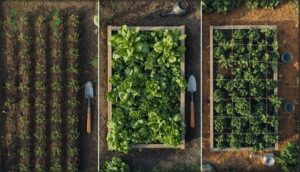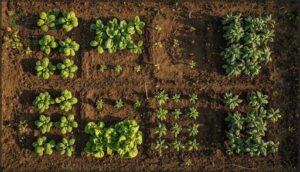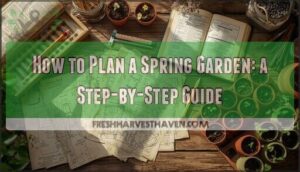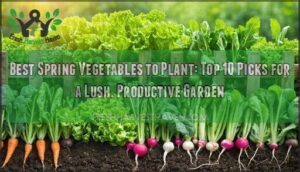This site is supported by our readers. We may earn a commission, at no cost to you, if you purchase through links.
Your spring garden won’t reach its full potential if vegetables end up competing for sunlight, crowding each other’s roots, or struggling in poorly drained soil. The difference between a mediocre harvest and baskets full of fresh produce often comes down to how you arrange your plants before the first seed goes into the ground.
A well-planned spring garden vegetable layout accounts for each crop’s space requirements, sun exposure needs, and growth habits—turning limited garden space into a productive food source.
Whether you’re working with a small raised bed or a sprawling backyard plot, the steps ahead will help you map out a layout that sets your vegetables up for a thriving spring season.
Table Of Contents
- Key Takeaways
- Assessing Your Spring Garden Space
- Choosing The Best Garden Layout Style
- Planning Vegetable Placement for Spring
- Creating a Square-Foot Garden Layout
- Designing Raised Bed Vegetable Gardens
- Companion Planting and Crop Rotation Tips
- Managing Water, Pests, and Maintenance
- Frequently Asked Questions (FAQs)
- Conclusion
Key Takeaways
- Your spring garden’s success depends on measuring your space accurately, mapping sunlight patterns for at least six hours of direct sun, and testing soil pH between 6.0 and 7.0 before you plant anything.
- Square-foot gardening and raised beds deliver significantly higher yields per square foot than traditional rows by eliminating wide pathways, improving drainage, and allowing you to control soil quality from the start.
- Companion planting pairs like tomatoes with basil or carrots with onions naturally reduce pests and boost yields by up to 32%, while rotating crop families each season builds soil health and disrupts pest cycles.
- Drip irrigation cuts water use by 50% compared to sprinklers, and combining it with weekly soil checks, early pest barriers, and proper plant spacing prevents most common problems before they start.
Assessing Your Spring Garden Space
Before you plant a single seed, you need to know what you’re working with. Taking a close look at your available space helps you choose the right layout and avoid common mistakes.
Let’s walk through three key factors that will shape your spring garden plan.
Measuring Available Area
Before you sketch a single garden layout design, grab a tape measure and walk your yard. Accurate area calculation sets the foundation for smart space optimization and small space gardening success. Start your site assessment by measuring length and width, then multiply to determine total square footage.
- Use GPS-enabled mapping apps like Mapulator for precise garden mapping and yard measurement
- Sketch irregular boundaries on paper to break complex shapes into measurable rectangles
- Plan 100 square feet per person for typical spring vegetable needs and efficient garden space utilization
Considering essential garden size needs is vital for a successful harvest.
Evaluating Sunlight and Shade
Once you’ve measured your space, map sunlight exposure to realize your garden’s full potential. Observe sunlight patterns on several clear days, noting where solar intensity peaks and where shade gardening opportunities emerge.
Most vegetable garden layouts need six hours of direct sun, though leafy greens thrive in partial shade gardens with four to six hours. Understanding your garden’s partial sun conditions is key to selecting the right plants.
Garden orientation and light filtering from trees or structures shape your planting strategy.
Considering Soil Quality and Drainage
After checking light, turn your attention to what’s beneath: soil preparation sets the stage for healthy growth. Soil testing reveals pH levels—vegetables flourish between 6.0 and 7.0—and guides amendments like lime or sulfur.
Evaluate these soil health factors:
- Drainage systems—standing water invites root rot in over 70% of cases
- Organic matter content for water retention and aeration
- Soil texture affecting root development
- Compaction requiring soil aeration
- Water table management near low-lying areas
Poor soil drainage cuts yields sharply, but raised beds boost spring productivity by 30%. Work in compost 1 to 4 inches deep when ground crumbles easily. Garden soil mix quality determines your harvest success, making organic gardening methods worth the upfront effort.
Choosing The Best Garden Layout Style
Your garden’s layout shapes how much you can grow and how easily you’ll manage it throughout the season. Different styles work better for different spaces, skill levels, and physical needs.
Let’s look at three popular approaches that can help you make the most of your spring planting area.
Square-Foot Gardening Basics
Square-foot gardening layouts transform limited space into productive plots by dividing a 4×4-foot raised bed into sixteen one-foot squares using a lattice design. You’ll plant 1, 4, 9, or 16 vegetables per square depending on crop size, achieving space optimization that can yield 100% more than traditional rows.
This garden planning and design approach simplifies crop rotation and reduces weeding through dense planting.
Traditional Row Vs. Raised Bed Layouts
Your choice between row gardens and raised bed garden layouts affects both space efficiency and crop yield. Raised beds deliver five times more produce per square foot by eliminating wide pathways and improving soil quality with added amendments. Rows work better for mechanized large-scale plots, but beds excel in backyard settings with these advantages:
- 80% of surface area grows vegetables versus 60% in rows
- Soil warms two weeks earlier for faster spring planting
- Weeding drops by half due to dense plant spacing
- Garden accessibility improves for those with limited mobility through raised bed construction
Container and Vertical Gardening Options
When ground space is scarce, container gardening and vertical gardening transform balconies and patios into productive zones. Urban farming thrives through vertical gardens that stack crops upward, while container vegetable garden setups allow you to move plants for ideal sun exposure.
Space optimization matters—container sizes directly affect root development and yields. These small space gardening systems work exceptionally well for compact spring vegetables and herbs.
Planning Vegetable Placement for Spring
Planning where to put your vegetables in spring sets the stage for a productive garden all season long. You’ll want to think about which crops go in first, how to keep harvests coming, and where to give sprawling plants room to stretch.
Let’s walk through three key placement strategies that make your spring layout work harder for you.
Arranging Cool-Season Crops
When soil temperature reaches 45°F and stays workable, your cool-season crops are ready to take their place in the spring-harvest vegetable garden. Think of garden mapping like solving a puzzle—taller plants go north, frost protection benefits the hardiest varieties, and seed selection determines your spacing needs.
- Position broccoli and kale on the north edge to prevent shading shorter crops like lettuce and radishes.
- Start peas near trellises for efficient space use and improved air circulation.
- Plant carrots and spinach in blocks rather than rows, maximizing your square foot gardening potential while planning for companion planting garden benefits and crop rotation.
Designing for Succession Planting
Planning for succession sowing turns one planting bed into three or four separate harvests—a garden mapping essential you can’t skip.
Reserve dedicated 1×3-foot sections for staggered plantings every two to three weeks, rotating lettuce, spinach, and radishes through the same space.
This spatial planning approach triples production from limited square footage while supporting crop rotation and harvest optimization throughout spring.
Allowing Space for Sprawling Plants
Squash, potatoes, and melons need room to breathe—allocate at least 3 to 4 feet per plant to prevent overcrowding effects that slash your yield maximization potential.
Growth habits matter when developing vegetable garden layout ideas: vine support and trellis usage turn sprawling cucumbers and beans vertical, improving space efficiency in raised bed gardening while enhancing companion planting opportunities and overall garden planning success.
Creating a Square-Foot Garden Layout
Square-foot gardening transforms a simple 4×4-foot box into a productive mini-farm that’s perfect for beginners. The secret lies in dividing your bed into a grid and planting each square according to the crop’s size and spacing needs.
Here’s how to set up your layout, space your plants correctly, and get the most from every square inch.
Grid Setup and Lattice Organization
A well-marked grid transforms your raised bed gardening experience into a productive, easy-to-manage system. Setting up a lattice for your square foot garden layout takes about 15 to 30 minutes and provides clear boundaries for each planting zone.
- Use wood, PVC pipe, or nylon string to create visible 1-foot squares
- Divide 4×4 beds into 16 equal sections for garden planning
- Choose permanent lattice materials that last 4–6 years
- Reduce seed waste by 25% with marked vegetable garden layout ideas
- Improve spatial efficiency and water distribution across your garden
Optimal Plant Spacing by Crop
Once you’ve laid out your grid, you’re ready to match each crop to its planting space. Lettuce and spinach work best at 4 per square, while carrots and radishes fit 16 in the same area—this crop density directly affects yield optimization.
Tomatoes need 24–36 inches apart, reducing disease and boosting your spring harvest vegetable garden.
Proper plant proximity prevents soil erosion, improves garden efficiency, and fosters healthy succession planting across your vegetable garden plan.
Maximizing Harvests in Small Spaces
Spacing your plants well opens the door to bigger yields through vertical gardening—train beans and peas upward to free ground room. In raised beds and small gardens, vertical structures and careful container selection turn limited square footage into productive vegetable garden layouts without wasted space.
Pair succession planting with companion planting to layer harvests, and build soil fertility with compost between crops.
Designing Raised Bed Vegetable Gardens
Raised beds give you control over your soil, drainage, and planting conditions from the ground up. They’re especially useful if you’re working with heavy clay, compacted earth, or areas that don’t drain well.
Let’s walk through how to size, frame, fill, and maintain your raised beds so they work hard for you this spring.
Sizing and Framing Raised Beds
When building raised beds, aim for widths between 18 inches and 4 feet—you should reach the center without stepping inside. Four feet works well when you can access all sides, but cut that to 2 feet if your bed sits against a wall.
Heights of 12 to 18 inches accommodate most vegetables, though taller frames around 24 inches improve accessibility and drainage for spring crops.
Soil Preparation and Amendment
Once your frame’s ready, start with soil testing to check pH and nutrient levels—aim for 6.0 to 7.0. Then improve structure with organic amendments:
- Spread 2–3 inches of compost across the bed to boost moisture retention and nutrient management.
- Blend in aged manure for nitrogen-rich organic gardening fuel.
- Add coarse sand or perlite if drainage feels sluggish.
- Turn everything 8 inches deep for even soil preparation and composting integration.
Access and Maintenance Considerations
Beyond the bed itself, smart access choices prevent unnecessary headaches. Plan pathways at least 24 inches wide—enough for wheelbarrows and comfortable kneeling. Gravel or brick improves drainage and cuts mud by twenty percent, while proper spacing makes raised bed layouts more accessible for small gardens. Schedule weekly checks and soil drainage tests to keep garden maintenance simple and your harvest steady.
| Feature | Standard Option | Accessible Option |
|---|---|---|
| Pathway Width | 24–36 inches | 48+ inches (wheelchair) |
| Surface Material | Gravel, flagstone | Firm, smooth pavement |
| Bed Height | 12–18 inches | 24–30 inches (reduced bending) |
| Tool Storage | Shed or corner | Mounted racks at waist level |
Companion Planting and Crop Rotation Tips
Planning where your vegetables grow isn’t just about filling empty space—it’s about creating partnerships that help your plants thrive. Some vegetables naturally support each other, while others need to move around your garden each year to keep the soil balanced.
Let’s look at three practical ways to organize your spring garden for healthier plants and better harvests.
Pairing Compatible Vegetables
Think of companion planting as creating garden synergy—certain vegetable pairings work better together than alone. Tomatoes and basil form a classic match, with basil helping repel pests while tomatoes provide shade. Carrots and onions deter each other’s pests when grown side by side.
Plant diversity strengthens your spring vegetable gardening efforts, as beans fix nitrogen to boost corn growth. These vegetable garden layouts naturally reduce pest problems and can increase yields by an impressive 32%.
Rotating Crops for Soil Health
You’ll protect your soil’s future by moving vegetable families to different beds each season. Crop rotation builds soil resilience and boosts nutrient cycling naturally—legumes add nitrogen that next year’s leafy greens will love.
This simple practice strengthens soil microbes by up to 29% while disrupting pest control cycles. Plan your succession plantings now so each bed gets a fresh start next spring.
Incorporating Herbs and Edible Flowers
Edible flowers and herbs transform your kitchen garden into a hardworking companion planting system. Basil planted near tomatoes sharpens flavor enhancement, while calendula traps aphids—that’s pest management built right into your garden layout.
Annual herbs like parsley make perfect raised bed edges, while pollinator attraction from violas boosts yields by 15-25%. This spatial integration adds aesthetic diversity without stealing valuable vegetable space.
Managing Water, Pests, and Maintenance
Even the best-planned spring garden won’t thrive without consistent care and attention.
Water, pests, and daily upkeep can make or break your harvest before summer arrives.
Let’s look at practical ways to keep your vegetables healthy and productive throughout the growing season.
Efficient Irrigation Strategies
Water conservation starts with drip irrigation, which reduces water use by up to 50% compared to sprinklers. You can pair this with soil monitoring sensors to track moisture levels and adjust your irrigation scheduling accordingly.
Smart watering systems automate the process based on real-time data, ensuring your vegetable garden planning includes efficient drainage and proper soil preparation and health for consistent spring growth.
Protecting Plants From Pests
Spring pest control methods work best when you catch problems early. Your vegetable gardening success relies on combining organic repellents and barrier techniques before insects settle in.
- Physical Protection – Install garden mesh fabric or floating row covers from planting day to block flea beetles and aphids while letting sunlight through.
- Companion Planting – Place marigolds between rows to draw pests away from crops and attract beneficial insects.
- Biological Controls – Introduce ladybugs and praying mantises for natural insect management of aphids and whiteflies.
- Cultural Practices – Rotate crops annually and remove damaged leaves to disrupt pest life cycles.
Routine Tasks for a Productive Spring Garden
Beyond pest barriers, your spring vegetable gardening success depends on weekly care routines. Water conservation starts with morning irrigation and drip systems that cut waste by 60%. Check soil moisture twice weekly and clean tools after each use—that simple habit reduces disease spread by 80%.
Track your garden plan with a seed-sowing chart, note what thrives, and prep beds with soil testing before planting.
Frequently Asked Questions (FAQs)
How do I start seeds indoors before spring?
You’d think tiny seeds would thrive anywhere, yet most fail without the right setup.
Start seeds 6-10 weeks before your last frost using sterile soil mix, bright grow lights, and consistent warmth between 60-80°F for strong transplants.
What are the best mulching materials for vegetables?
Grass clippings and hemp bedding excel at water retention, holding 73% and 80% of moisture respectively.
Black plastic warms soil by up to 6°C, while compost and bark reduce weeds and improve structure.
When should I transplant seedlings outside?
You can transplant seedlings outside once soil temperatures reach 50–60°F and frost dates pass.
Harden off gradually over seven to ten days, increasing outdoor exposure daily for your growing season success.
How do I protect crops from late frosts?
Cover your plants with frost fabric or row covers when temperatures drop. Water soil lightly beforehand to retain heat. Remove coverings in the morning to prevent overheating and moisture damage.
Can I grow vegetables in partial shade?
You can grow vegetables in partial shade—leafy greens, root crops, and some herbs thrive with four to six hours of sunlight.
Shade-tolerant crops grow slower but remain productive in reduced sunlight conditions.
Conclusion
Some gardeners think tossing seeds into the dirt and hoping for the best counts as planning. Spoiler: it doesn’t.
A thoughtful spring garden vegetable layout transforms chaos into order, giving each plant the room, light, and soil it needs to thrive. You’ve mapped your space, chosen compatible crops, and arranged them with intention.
Now your garden has a real shot at success—not because you got lucky, but because you planned for it.
- https://njaes.rutgers.edu/fs129/
- https://extension.unh.edu/resource/preparing-vegetable-garden-site
- https://www.marysheirloomseeds.com/blogs/news/plant-spacing-chart-for-veggies
- https://extension.umd.edu/sites/extension.umd.edu/files/2023-04/CCMG%20GIEI%20Garden%20Planning%20Presentation.pdf
- https://www.udel.edu/academics/colleges/canr/cooperative-extension/fact-sheets/planning-a-vegetable-garden/












